The Jewish Traveler
Feature
Brighton & Hove
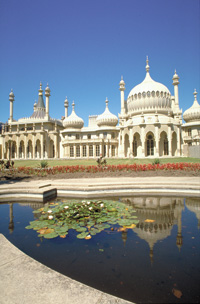
Visitors to Brighton & Hove might be surprised to see the name of a 19th-century Jewish police chief emblazoned across the front of a city bus. In this English resort where Jews have long played a significant role, Henry Solomon is one of the past notable residents honored by having a bus named for them.
Brighton (joined in the last 20 years with more genteel Hove) began as the simple fishing village of Brighthelmstone, sandwiched between the English Channel and the gently rolling hills of the South Downs. It evolved into the favorite watering hole of British aristocracy, where the Prince Regent (the future King George IV) built the Royal Pavilion and frolicked with his courtiers, enjoying a wildly extravagant lifestyle that changed the town forever. Eventually, the carriage crowd gave way to ordinary holidaymakers, attracted by the heady mix of ozone-rich air, historical charm and quirky atmosphere.
Like all Anglo-Jewish communities outside London and Manchester, the Jewish population in Sussex has dropped from its peak, but connected with neighboring Eastbourne, Worthing, Bexhill and Hastings, Brighton & Hove remains a major Jewish provincial presence.
History
Israel Samuels was the first recorded Jew in Brighton, in 1766, but it took 20 years for a community to be organized. Emanuel Hyam Cohen, a Bavarian immigrant married to local resident Hannah Benjamin, established a Jewish boys boarding school on the Brighton seafront; around 1792, he helped found the first synagogue on Jew Street. The synagogue later moved to nearby West Street in the center of the old town.
Brighton was elegant, fashionable and far from sedate. Jews were among the many visitors seeking invigorating sea air and rejuvenating seawater bathing and, by the end of the 18th century, at least six lodging houses were operated by Jewish families.
In 1808, the synagogue moved to Pounes Court, but closed in 1813—one man short of a minyan. Revived in 1824, the congregation moved to 38/39 Devonshire Place and later expanded its classical-style synagogue under the direction of noted architect David Mocatta. Jews were now active in civic and congregational affairs, especially Chief Constable Henry Solomon and Town Commissioners Hyam Lewis and Benjamin Lewis (who may have been related). Distinguished journalist Levi Emanuel Cohen edited the Brighton Guardian. But tragedy struck in 1844 when a suspect in police custody killed Solomon with a poker.
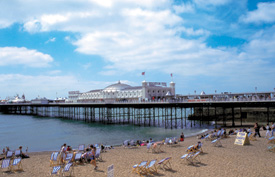
In spite of its small size and frequent shortage of funds, Brighton Jewry was remarkably generous. It responded to appeals for Syrian Jews after the Damascus Blood Libel in 1840; persecuted Russian Jewry; and newly established provincial synagogues in Britain. The Brighton Philanthropic Society (established in 1846) distributed regular aid to the Jewish community and the poor.
From the mid-19th century onward, Brighton boasted prominent Anglo-Jewish women writers, artists, performers and political agitators, including writer Grace Aguilar and portrait artist Julia Goodman. Eleanor Marx, daughter of Karl Marx, worked as an actress in Brighton.
Leading Jewish families—the Goldsmids, Mocattas, D’Aguillars (D’Avigdor), Salamons and, later, the Sassoons, De Worms and individuals such as A.G. Henriques, Jacob Montefiore and Bernhard Baron—visited Brighton. Many built summer homes. In the 1850s, Philip Salamons had a private rooftop synagogue at 26 Brunswick Terrace in Hove.
Isaac Lyon Goldsmid, the first English Jew to be made a baronet (Baron de Goldsmid da Palmeira), developed Adelaide Crescent and Palmeira Square residences on part of his Hove estate. Later, in the absence of male heirs, Queen Victoria allowed the title to pass to his female descendents. One of the baron’s granddaughters married Count Henry D’Avigdor and the family became D’Avigdor-Goldsmid.
In 1875, the congregation opened a lavish new synagogue on Middle Street to serve the influx of Jewish residents and visitors. Over the next decades, the wealthy Sassoon family funded various expansions and improvements in the synagogue, including installing electric light in 1892. The Sassoon brothers, Albert, Arthur and Reuben, hobnobbed with English high society and entertained royalty.
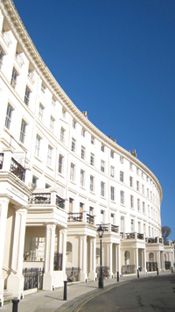
Brighton continued to attract more mainstream visitors and, by 1894, the community boasted 13 Jewish boarding houses and hotels. Jewish hotels flourished well into the 20th century but could not survive changing holiday styles. Late-19th-century Brighton was also known for its four Jewish boarding schools including two colleges for ladies. More schools were established between the 1920s and 1950s, especially Whittingehame College, founded by Jacob Halevy as a “Jewish Eton,” and Aryeh House. Decades later, the only remaining Jewish day school closed.
In the 1920s, some East European immigrants broke away from Middle Street’s Anglo-Jewish formality to form Brighton Hebrew Orthodox congregation on New Church Road. Another Orthodox house of worship, West Hove Synagogue, later opened on Holland Road to serve that area. In 1933, the Progressive Synagogue opened and the Brighton & Hove Reform Congregation arrived in 1955.
During World War II, Jewish American and Canadian soldiers, billeted in Brighton hotels, were often invited to homes for Friday night dinner. The community peaked in the 1950s and 1960s with many local Jewish-owned shops and professionals, but the majority of Jews commuted to work in London. Jewish teenagers used to gather on the pebbly stretch below Brunswick Square they dubbed “Maccabi Beach.” Although the number of Jews declined over the years, the community always remained strong.
Community
Currently, Brighton & Hove has an estimated Jewish population of 5,000 (including many retirees) plus dozens of unaffiliated and uncounted Jews. The two Orthodox synagogues account for some 525 members. The Brighton & Hove Hebrew Congregation (also known as New Church Road Shul; 011-44-1273-888-855; www.bhhc-shul.org) is led by Rabbi Hershel Rader. Rabbi Vivian Silverman is in the pulpit at The Hove Hebrew Congregation (aka Holland Road; 44-1273-732-035; www.hollandroadshul.com). Each synagogue holds independent Shabbat services; daily prayers, adult classes and events alternate between the two locations.
At the Brighton & Hove Reform Congregation (44-1273-735-343; www.bh-rs.org), Rabbi Andrea Zanardo ministers to about 400 members in its building on Palmeira Avenue, in Hove (currently undergoing renovation). The Brighton & Hove Progressive Synagogue (44-1273-737-223; www.bhps-online.org) on Lansdowne Road in Hove claims 300 members throughout Sussex. Rabbi Elizabeth Tikvah Sara, known as “Elli,” is the congregation’s feminist leader.
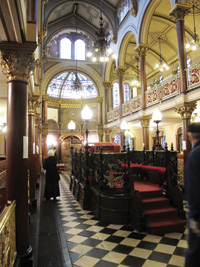
Chabad Lubavitch Foundation of Brighton (44-1273-321-919; www.lubavitchbrighton.com) was founded in the 1980s when Rabbi Pesach Efune and his wife, Penina, opened the Chabad House at 15 The Upper Drive Hove.
Brighton & Hove Jews of all affiliations come together for the annual menora lighting in Palmeira Square, Mitzvah Day and Holocaust memorial events. “Cooperation between the different facets of the Jewish community in East Sussex sets a paradigm for other places,” says Dr. Sam Barsam, a long-time resident and member of the Sussex Jewish Representative Council that connects some 50 local Jewish organizations (www.sussexrepresentative council.org). Ralli Hall is a social and cultural Jewish center for all ages. Elderly and frail residents are cared for in the community’s kosher Hyman Fine House. Jewish students enjoy varied programs during the school year at the Hillel House behind Middle Street synagogue. Other organizations include a Council of Christians & Jews and Christian Friends of Israel, based in nearby Hastings. The Sussex Jewish News (https://sussexjewishnews.com) is updated monthly.
Though there are no kosher restaurants, kosher food items are available in local supermarkets. Halla arrives at Premier Convenience store on Hove Street every Thursday.
Sights
The website www.jtrails.org.uk/trails/brighton-and-hove offers walking tours of Jewish-connected places in Brighton & Hove. Jewish street names include Goldsmid, Montefiore and Jew Street. Nothing remains of the original synagogue except a doorway marked by a blocked archway near 14 Bond Street. However, an inscription—“Jews Synagogue 5598 (1838)”—is visible under the pediment of the elegant Regency building at 38/39 Devonshire Place. Now converted to luxury apartments, the façade has a historic marker recognizing architect Mocatta, who also designed the now-restored, grandiose façade of Brighton Railway Station.
Nearby Middle Street Synagogue (www.bhhc-shul.org) is open to the public on certain occasions and some Sundays. The muted brick exterior contrasts with the jewel-like interior highlighted by brilliant stained-glass windows. Note the cast-iron columns embellished with biblical fruits that support the ladies’ galleries. Brass, marble and rosewood combine to create a lavish house of worship. In the foyer, somber memorial boards list members who fell in the world wars. The synagogue underwent a full restoration a decade ago.
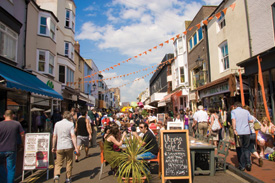
Back on the seafront, the Brighton (Palace) Pier was financed in 1899 by Sir John Howard, a Jewish entrepreneur, engineer and railway director. Each year millions of visitors still enjoy the pier’s traditional fish and chips, cotton candy and arcade. For a quirky Jewish connection, tours of the Old Police Cells Museum (located in Brighton Town Hall, Bartholomew Square; www.oldpolicecellsmuseum.org.uk) show where Chief Constable Solomon was murdered.
Going north from Town Hall brings you to The Lanes’ narrow streets. Across North Street, minarets and onion domes mark The Brighton Royal Pavilion (www.brighton-hove-rpml.org.uk). This Indian/Asian fantasy palace shows off King George IV’s grossly expensive taste. Visitors tour rooms furnished with oriental-style grandeur and see the great kitchen, where elaborate banquets featuring up to 60 dishes were prepared.
The pavilion anchors the Cultural Quarter, home also to the Brighton Museum & Art Gallery (in the former palace stables), the Brighton Dome and the Theatre Royal. Old Brighton’s charm is palpable in nearby North Laine, a quirky maze of alleyways lined with shops and pubs. Flights of steps connecting different levels of buildings were traditionally known as twitters and cat creeps.
Turn south again, back to the seafront, and turn right. Ornate ironwork railings, white stonework and an expanse of windows mark The Grand, the iconic hotel that has been lording it over the English Channel for 150 years.
In contrast to the overindulgent decor of the pavilion, the Prince Regent also helped usher in the tasteful Regency style in architecture and design. Wealthy Jews were among area residents who constructed magnificent squares and crescents of fine Regency houses around green lawns sweeping down to a broad oceanfront promenade.
Lamppost styles change as you cross from Brighton into Hove, where the seafront boundary is marked by the imposing 1912 Peace Statue. The 3-foot-high bronze angel holds an orb and an olive branch, in a memorial to King Edward VII, known as the Peacemaker. Arthur Sassoon, a personal friend of the late king, donated 100 pounds—approximately $170—toward building the statue.
Sloping up from the Hove seafront are stunning examples of English Regency architecture laid out in elegant squares and crescents, especially Brunswick Square and Brunswick Terrace.
Culture
Brighton’s vibrant cultural life plays out year-round in The Brighton Centre; the 205-year-old Theatre Royal; the Brighton Dome and Komedia comedy club.
For three entertaining weeks each May, Brighton Festival (England’s largest arts festival; https://brightonfestival.com) brings all things artistic to traditional venues, parks and unusual spaces across the city.
Jewish cultural activities are ongoing, with a Brighton Jewish Arts Society; the Jewish Film Club; and the Sussex Branch of the Jewish Historical Society. Brighton hosts a local Festival of Jewish Music. Events associated with the London-based Jewish Book Week take place in February and March. The United Kingdom Jewish Film Festival began as the Brighton Jewish Film Festival in 1997 and continues here annually.
Personalities
Several prominent Jews were involved in the London and Brighton and South Coast Railway including Leo Shuster, Ralph Lopes, Jonas Levy, Member of Parliament Sir Julian Goldsmid and Baron Ferdinand de Rothschild. Another Jew commemorated on a Brighton bus is Lord Cohen, mayor of Brighton from 1956 to 1957. Sir Hans Singer was an eminent economist at Sussex University. Alfred Feld, mayor, hotelier and tourism expert, helped develop the Brighton Centre in 1977. Aid worker Sally Becker, known for her rescue of children during the Balkan war, grew up in Hove and lives there today (see profile here).
Reading
Brighton Rock, Graham Greene’s famous novel of 1938, describes his contemporary, unsavory Brighton, including Jewish mobsters. It was made into a play, a musical and films (in 1947 and 2010).
Day trips
Picturesque coastal towns, spectacular scenery and quaint villages set in the green Sussex countryside are accessible by bus or train from Brighton or Hove stations. Well-marked walking, cycling, even horseback-riding trails crisscross the South Downs (www.brighton-hove.gov.uk).
You can observe the blacksmith and wheelwright’s traditional craft at the South Downs Heritage Centre in Hassocks (www.south-downs.co.uk) or ride vintage steam engines on the Bluebell Railway (www.bluebell-railway.com) or Kent and East Sussex Railway (https://kesr.org.uk).
History is tangible in Sussex’s stately homes and castles, including the 900-year-old fortress at Arundel, 14th-century Bodiam Castle and 1,000-year-old Lewes. Find a wealth of local museums, gardens and heritage centers listed at www.sussextopattractions.co.uk.
Recommendations
Brighton & Hove have nearly 50 hotels but The Grand (97-99 Kings Road; www.devere-hotels.co.uk) is a time warp of charming Victorian character and modern amenities. The magnificent staircase curving up seven floors is a masterpiece.
At the other end of the spectrum are Brighton’s sleek boutique hotels. The 20-room Drake features refined luxury in an oriental-colonial décor. The Drake is located at 43-44 Marine Parade (www.drakesofbrighton.com).
For general visitor information, check with Brighton Visitor Information Center (www.visitbrighton.com).
When tourist fatigue hits in London, ride the train to Brighton & Hove. History (with a strong Jewish component), refined architecture and bracing sea air combine to create a strong sense of place.










 Facebook
Facebook Instagram
Instagram Twitter
Twitter
Paul Wilken says
Benjamin Lewis was the son of Hyam Lewis
martin sugarman says
Does anyone know anything about the Abrams family of Brighton who lost a son Jack Samuel Abrams in the army in 1940 in WW2? Are there descendants still in Brighton and are the parents of Jack buried in Brighton?